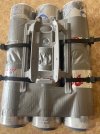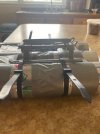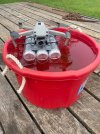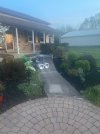Rather than clog up someone else's thread and to make it possible to find in a search should anyone in the future want to check it out, I'm starting my own thread on this. If mods would prefer, I will not be offended if it gets merged with another thread.
A friend and I are going fishing in the Inner Passage this summer and he wants some sort of rescue device on his Air 2S, should it end up in the drink. I also have an Air 2s so I can do this. We are each making our own design to see what works. I already own a landing gear, set of skids as can be seen in the pictures, which help with attachment of the raft I put together. I like that landing gear and would recommend it as an accessory. I can also attach a flashlight or two to them if I want.
Of course, the beer cans are empty and the tops are taped together with duck tape, which is waterproof. I have flown it a bit but am still testing its function and characteristics with the floats attached. In a full throttle run, I got about 9 1/2 minutes of flight time. I have landed and launched it in my pool and am even able to taxi it around in the pool. As configured, it will only land in Sport mode but I may modify the raft to give the sensors sight of the ground. I expect that the winds will affect it but have yet to test it in windy conditions.
My first prototype consisted of two tubes but it was unstable, to say the least. The addition of the third tube works wonders. After I read up the pointers I was given on how, I will upload data logs of my flights.
My buddy is making his out of pool noodles but thus far, he is not fairing as well as I am. He's only using two noodles so far but his goes into a spin, he's still going at it. One advantage that mine has is that we don't have to tote it with us to AK, we can drink some beers there and assemble it on site.
I kind of like my own Rube Goldberg inventions.
Oh, and I am trying to get him to bring his over and record mine in action. So far, no videos.




A friend and I are going fishing in the Inner Passage this summer and he wants some sort of rescue device on his Air 2S, should it end up in the drink. I also have an Air 2s so I can do this. We are each making our own design to see what works. I already own a landing gear, set of skids as can be seen in the pictures, which help with attachment of the raft I put together. I like that landing gear and would recommend it as an accessory. I can also attach a flashlight or two to them if I want.
Of course, the beer cans are empty and the tops are taped together with duck tape, which is waterproof. I have flown it a bit but am still testing its function and characteristics with the floats attached. In a full throttle run, I got about 9 1/2 minutes of flight time. I have landed and launched it in my pool and am even able to taxi it around in the pool. As configured, it will only land in Sport mode but I may modify the raft to give the sensors sight of the ground. I expect that the winds will affect it but have yet to test it in windy conditions.
My first prototype consisted of two tubes but it was unstable, to say the least. The addition of the third tube works wonders. After I read up the pointers I was given on how, I will upload data logs of my flights.
My buddy is making his out of pool noodles but thus far, he is not fairing as well as I am. He's only using two noodles so far but his goes into a spin, he's still going at it. One advantage that mine has is that we don't have to tote it with us to AK, we can drink some beers there and assemble it on site.
I kind of like my own Rube Goldberg inventions.
Oh, and I am trying to get him to bring his over and record mine in action. So far, no videos.
















